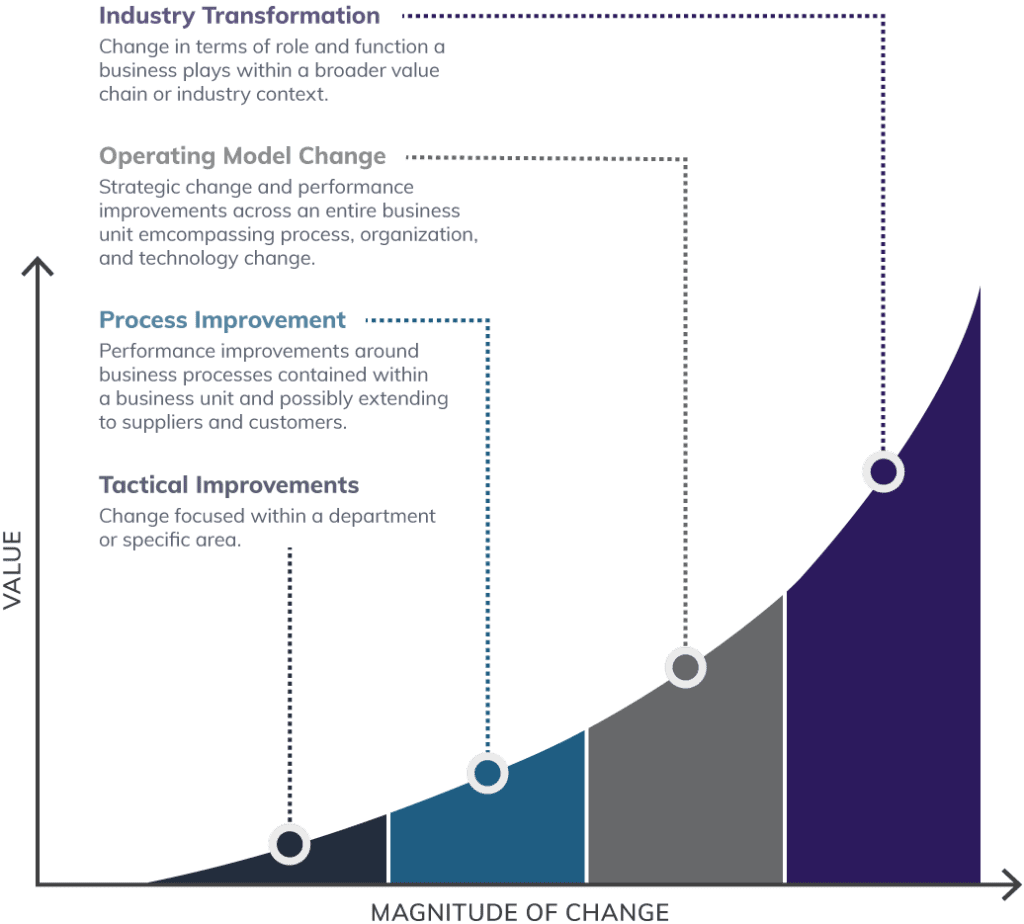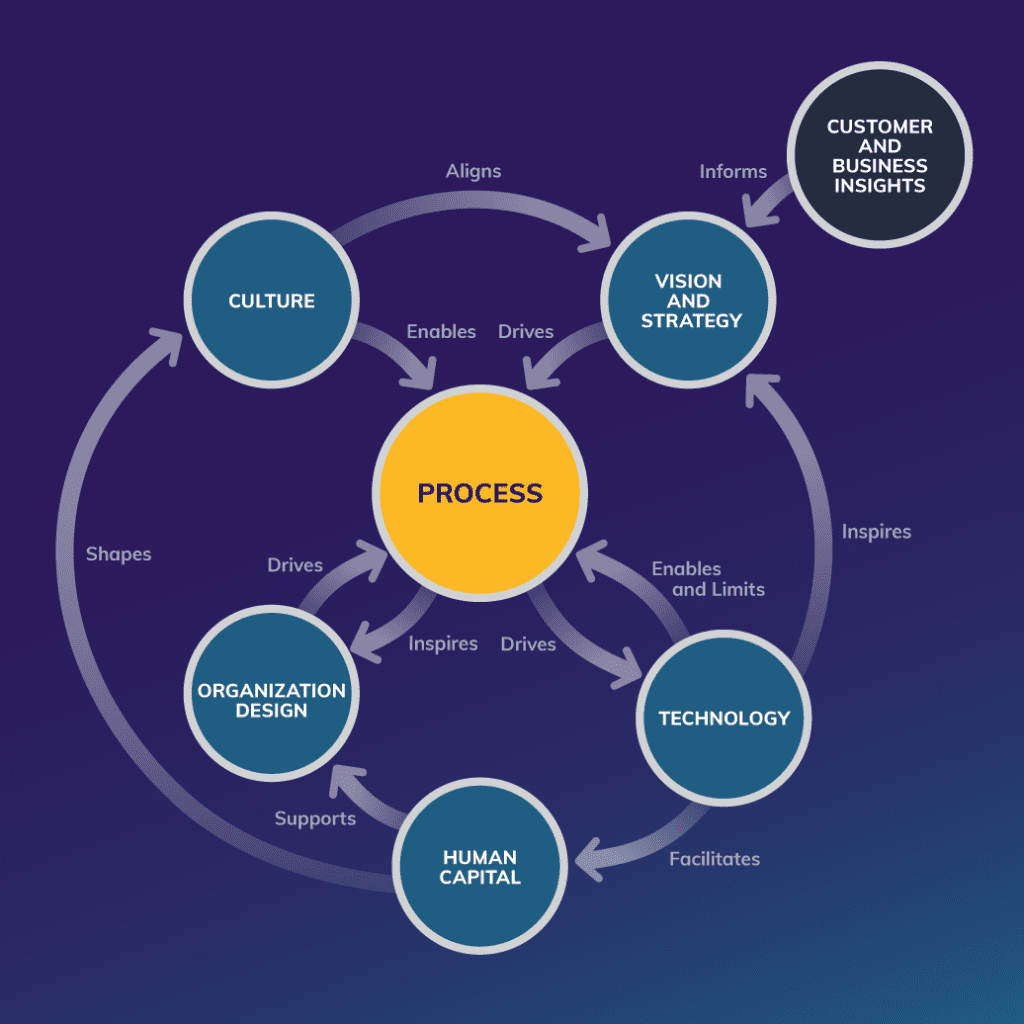Process transformation is more than a one-time initiative — it’s an ongoing evolution that enables businesses to stay competitive and responsive to change. This guide consolidates key insights on process transformation, leadership, and agility, providing a strategic playbook for organizations.
In brief:
- When it comes to process transformation, think marathon, not sprint. It isn’t a project you check off your list. It’s an ongoing evolution that keeps you ahead of shifting customer expectations and market disruptions.
- You need real-time business insights, adaptive strategy, agile architecture, continuous value delivery, engaged people, and smart portfolio management working together. Miss one, and your transformation stumbles.
- Your leaders need technical expertise, political savvy, genuine trust and transparency, emotional intelligence to navigate change, and the courage to face uncomfortable truths.
- Let your problems drive your tech choices. AI and automation should solve specific business challenges, not lead your strategy.
More than ever, companies are under significant pressure to innovate, stay ahead of competitors, and operate at high-performance levels.
High-performing organizations that can effectively transform in today’s market will thrive while lagging businesses will cease to exist.
What Is Process Transformation?
We define process transformation as driving competitive advantage by continuously deploying strategic changes and performance improvements across an organization, encompassing people, process, and technology.
To this end, business process transformation involves a complete overhaul of existing business processes. It goes beyond simple, surface-level improvements and results in fundamental change.
Today’s business leaders realize that to navigate the challenges — and opportunities — presented by ongoing disruption, they need to reevaluate and transform business processes.
While the amount of change necessary within an organization varies greatly, most companies find that their business transformation needs extend far beyond tactical and operational improvements. This is why a successful transformation often requires a shift in an organization’s core strategy and operating structures and — in some cases — the company’s underlying business model.
The following graphic illustrates the typical ranges of business transformation. As transformation initiatives grow in size and complexity, their value increases.
As a result, the very definition of business transformation must evolve to reflect the increasing magnitude of change and the need for continuous evolution rather than one-and-done deals.
The business transformation process is not a one-time job, nor is it just one process.
6 Key Components of a Successful Process Transformation
Since business transformation is so complex, you must take a thoughtful, agile approach to it.
Don’t approach process transformation as a one-time project. Instead, view it as a continuous process overhaul. Start with analyzing your current situation and the business drivers impacting your business, including customer, competitor, regulatory, and internal pressures. Essentially, you need a 360-degree understanding of your organization’s performance.
From there, you can develop a compelling vision, strategy and business architecture to guide the ideation, design and delivery of world-class business capabilities in an agile fashion to quickly drive value. And, of course, you must enable and sustain this change by intentionally focusing on people, culture and change governance.
The graphic below defines Centric Consulting’s perspective on the six key elements that are essential to successful business transformation.
It is important to note that this does not imply a sequential or waterfall-based approach to address the various aspects of transformation. As companies respond to changing market dynamics, they need to integrate each of these six elements continuously.
Let’s review the six key components of a successful process transformation in more detail.
1. Business and Customer Insights
You must know where you stand today to transform your organization. Customer expectations, technological advancements, and new competition can rapidly change, and your position can shift in the blink of an eye.
As a result, your organization must gather and process real-time business and customer insights and effectively use these analytics to feed planning and operational activities.
2. Vision and Strategy
Companies can no longer rely on three- to five-year strategies (or even one-year strategies) to guide their organization. Dynamics change too rapidly. You still need a strategy to guide your organization, but it can’t be so rigid that you can’t make adjustments based on current and future business drivers.
3. Business Architecture
To enable adaptive change, companies must inherently build agility into their process designs, organization structures, workforce, and technology infrastructures. So, each of these elements must work together cohesively to ensure you can continue delivering world-class capabilities as business requirements change.
4. Agile Value Delivery
Organizations must continuously and incrementally deliver value to the marketplace. Business and IT teams must collaborate closely to provide new business capabilities at an accelerated pace. To do that, your company must use agile and modern software delivery techniques that can help you create and bring new products and services to the market.
5. People and Culture
Your organization can’t effectively transform with an agile mindset without a focus on people. Companies must build change leaders across their company and establish a culture of change that engages all employees.
6. Enterprise Portfolio Management
Enterprise portfolio management (EPM) historically received a bad reputation due to a bureaucratic way of doing things. Today, EPM is a strategic business capability that makes it faster to implement strategies and realize their values, rather than hindering it.
To put the above components of a successful transformation to good use, glean insights from your business and customers.
Use Customer and Business Insights in Transformation
Companies must understand the sometimes-brutal realities facing their business from a customer, employee, and market point of view. That’s why gathering real-time customer and business insights is more important than ever. These insights inform company strategy, priorities and decision-making, as well as help your company adapt with agility.
Here are a few approaches to help you use the critical customer and business insights you need to fuel your agile business transformation.
Best Practices for Incorporating Insights Into Decision-Making
Follow these best practices to streamline how you harvest insights and use them to make effective decisions:
- Adapt to continuously deliver innovative products, compelling value propositions, and unmatched customer experiences.
- Deeply understand current and prospective customers’ wants and needs so you can address shifts in customer desires and business practices, as well as future disruptors.
- Avoid basing your analysis on human intuition or even historical performance. Customer behaviors are evolving too rapidly.
- Collect data in multiple ways, including generative and evaluative research using qualitative and quantitative approaches, to gain a better idea of your customers’ perceptions and expectations.
- Be willing to widen the scope of your data collection to capture as much insight about your customers as possible. This curiosity about your customers’ ever-changing needs is key to your survival.
- Adopt more progressive methods, such as social modeling and analytics-based research.
- Attain a 360-degree view of your business by looking internally and externally. Don’t be afraid to talk with your customers, suppliers, and other stakeholders, and even work with industry researchers and experts to learn where your business sits among the rest.
Your goal is to garner the best possible insights.
When looking externally across your industry, don’t evaluate only your current market and legacy competitors. Look at adjacent markets to learn about other opportunities and threats facing your organization too. To do this:
- Make competitor analysis a regular part of your business strategy.
- Evaluate potential competitors in adjacent markets trying to move into your industry.
- Keep an eye on disruptors (existing and startups) that could impact your entire business model.
- Think outside the box and look to seemingly unrelated industries for insights and inspiration.
DSW, for example, added nail bars to a few of their retail locations to increase foot traffic. Transitioning from a traditional retail store to an experience-based company helped ensure DSW’s survival even as they closed stores and reduced their real estate during the pandemic.
In another example, T-Mobile recognized the value of an adjacent market for opportunities. In 2019, the company adopted banking by offering mobile checking account services.
While your own business model may not change as radically as these examples, you should embrace an adaptable mindset to prepare for making the best possible decisions for your organization.
Aggregate Data in Real Time to Make Informed Decisions
To enable a 360-degree view of your organization, you’ll want to gather data and insights in real time so your organization can respond and adapt agilely. The good news is that integrated customer data platforms, artificial intelligence (AI), experience management platforms, and predictive analytics tools make it easier than ever to aggregate data.
With these tools, you can get a complete view of your organization and improve your decision-making. You can now more easily achieve real-time analytics — once a supreme technical challenge — with modern cloud technologies that offer new capabilities.
Companies now look beyond dashboards and reporting. They extract greater benefits from their data to enable process reengineering, improvement, automation, and management accountability. Indeed, these more mature data applications are necessary if your company wants to differentiate and compete in the current market. You will be primed to chart your best path forward when data-driven insights inform your every decision.
Charting a path for your process transformation that everyone in the organization can have confidence in requires a unique kind of leadership.
4 Core Competencies That Successful Leaders Need to Drive Process Transformation
Leadership plays a central role in a successful process transformation.
According to David A. Shore, an instructor at Harvard University, “When change initiatives fail (and they do so more often than not), they rarely fail on technical skills (hard skills) — they fail on the people skills. I have identified what I have come to call ‘The Great Enablers.’ While they are not the goal of any change initiative, they are the engine, and as such, they represent a cornerstone.”
The “Great Enablers” that Shore refers to have to come from leadership.
But leadership has to do more than get the transformation off the ground — they have to sustain it through ongoing support and advocacy.
This may involve assigning people to evaluate the effectiveness of the process transformation and gathering data about its effectiveness. At the same time, a good leader holds stakeholders accountable and uses their feedback to improve the transformation continuously.
But these responsibilities require unique leadership traits, such as:
1. Technical and Political Competency
Strong transformation leaders have technical and political competencies:
- Technical competency refers to expertise and technical skills in your field. You don’t need to know everything, but you need to have the technical knowledge to be a thought leader.
- Political competency refers to the ability to appeal to employees and address the organization’s public affairs internally and externally. Communicating effectively to a broader audience is important in times of drastic change.
Having both of these competencies helps give a leader a serious appreciation for their role in the change. A transformational leader is more than a title. Transformation leaders must persuade and influence teammates, subordinates, and other leaders.
In his book “How to Develop Gravitas,” management and strategic planning consultant Victor Cheng wrote, “When you have gravitas, you get taken seriously. Your opinions and insights are respected and sought after.”
This profundity can often distinguish leaders from managers. Managers have team members (who unwillingly or willingly report), while leaders have followers (who willingly follow). Technical and political competency arm you with the discernment to guide everyone in the same direction.
2. Trust and Transparency
If leadership is not transparent about why change is happening, they are unlikely to gain the employee trust and support needed to make it successful. Strong transformation leaders are trustworthy, but this trust goes both ways — they must also trust their employees.
People in charge of a change must have confidence in their people so that instead of micromanaging them, they can let them fail and learn on their own. Leaders support their people when they fail by maintaining a positive, supportive manner.
When everyone in the organization is trusted with a role in the transformation, they feel agency in joining and taking ownership of their part in the journey.
3. Emotional Intelligence
Emotional intelligence allows leaders to align people with change and gain their support in times of transformation. In their bestselling book “Emotional Intelligence 2.0,” Travis Bradberry and Jean Greaves define what this means:
“Emotional intelligence is your ability to recognize and understand emotions in yourself and others, and your ability to use this awareness to manage your behavior and relationships.”
Bradberry and Greaves argue that people must have emotional intelligence to develop relationships with others and successfully guide them through change. Strong transformation leaders build sustainable partnerships across the company hierarchy and empathize with people through careful listening and thoughtful response.
4. Courage
Strong transformation leaders must demonstrate the courage to step up. They should not be afraid to face the facts, especially in times of change. Transformation requires leaders to look realistically at their organization’s good and bad. Good leaders have the courage to do this enthusiastically and not avoid hard truths to self-protect.
Because transformations are typically multiyear journeys, they’re more likely to be successful when stakeholders have confidence in leaders to guide them throughout the course of the journey. The most successful changes are led by someone who can inspire others to see the larger outcome.
Achieving a longer-term outcome often means implementing multiple process improvements along the way. But what’s the difference between process transformation and process improvement?
Process Transformation vs. Process Improvement
Process transformation and process improvement are different in that transformation is always deeper and further reaching than business improvement.
Process improvement is limited because it doesn’t typically involve revamping core processes. For instance, a utility company can implement a process improvement to make it easier for customers to make payments. The company may, for example, have a programming team build a mobile payment portal into the utility’s app. This would improve the payment process for many customers.
A process transformation, on the other hand, may focus on revamping all of the following:
- The system used to collect payments
- How the system protects customer financial data
- Who oversees the payment system
- How the customer support team handles questions about payments and amounts due
- How the accounts receivable system integrates with the payment system
- Any integrations and automations between accounts receivable and/or payments and the utility’s accounting software
Even though these changes may also improve the process, the goal is to transform it so it’s not only better for customers but also supports more fluid, integrated, automated, and secure workflows across the organization.
Making this happen can seem daunting at first. Fortunately, technology can help you realize your transformation’s potential.
The Role of Technology in Process Transformation
Technology plays a critical role in inspiring your vision and enabling new business capabilities. Processes are fundamental in defining how your business performs and delivers value, driving organization design and resource requirements.
Digital workflows introduce unprecedented efficiency to process transformations, especially involving AI and automation. You can put the power of newer technologies to work for your transformation in many ways, whether you’re using a straightforward, generative AI-powered analytical solution or an intricate machine learning algorithm used for predictive analysis.
For instance, you can use AI, automation and digital workflows to support your process transformation when you’re:
- Garnering real-time customer and business insights to enhance decision-making and guide the business
- Understanding changing customer expectations
- Harnessing new technology to attain a 360-degree view of business performance
- Creating opportunities to aggregate data using integrated customer data platforms, AI, experience management platforms, and predictive analytics tools
- Streamlining workflows and establishing clear communication channels with baked-in flexibility, inclusivity, and ease of interaction
Select the Right Technology for Your Transformation Goals
To choose the right technology, let your desired outcomes drive the tech you choose instead of acquiring new tech and then adjusting your process so you can weave it in.
For example, you may have a large set of business data living in Excel spreadsheets. You need to analyze it to inform your process transformation better. While the data has been meticulously kept, you’re a long way from being able to analyze it to derive helpful insights. In this case, you can use AI to summarize the data, analyze it for trends, and even predict future business developments.
In this way, you use technology to solve your problems. On the other hand, if you try to stuff a round technological solution in a business challenge’s square hole, you may overcomplicate the process and inhibit efficiency.
Case Studies: How Amazon and GE Successfully Transformed Their Processes
Amazon has continuously transformed their supply chain to boost efficiency and improve customer satisfaction. To make this possible, the online retail giant has used robotics, automation, and AI. With these technologies, Amazon has optimized their inventory management, warehousing, and delivery systems.
General Electric (GE) needed to integrate digital technologies into their operations to discover ways to improve the quality and efficiency of their services. They connected turbines and engines to the internet. This enabled GE teams to collect and analyze data coming from each machine and then use that information to use each unit more efficiently.
Lessons From Successful Process Transformations
The key to a successful transformation is to embrace technologies, especially those that support automation and data-driven decision-making. It’s equally important not to lose sight of the end objective, which, in many instances, is to boost customer satisfaction. This means avoiding the tendency to innovate for innovation’s sake only.
Some organizations, for example, may want to engage in process transformations primarily to please their stakeholders. Even though this can have multiple benefits, taking this approach can result in losing track of the prime objective: earning and retaining customers to boost revenues.
Use Continuous Process Transformation for Consistent Business Growth
Process transformation is not a one-time event. Rather, it involves an ongoing evolution of your organization.
This means you must commit to continuous improvement that centers around agile development principles and incorporates customer feedback and business data. By using the approaches outlined in this guide, you can take a proactive stance toward process transformation and use it to steadily grow your business.
Companies that thrive are those willing to evolve, innovate and transform. Our experts specialize in business transformation — a holistic approach that reshapes your organization for sustained success. Kickstart your transformation journey. Contact us




